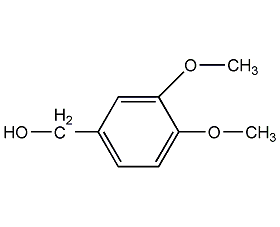
Structural formula
| Business number | 025M |
|---|---|
| Molecular formula | C9H12O3 |
| Molecular weight | 168.19 |
| label |
3,4-dimethoxybenzyl alcohol, veratryl alcohol, Ververatrol, 3,4-Dimethoxyphenylmethyl alcohol, (3,4-Dimethoxyphenyl)methanol |
Numbering system
CAS number:93-03-8
MDL number:MFCD00004638
EINECS number:202-212-0
RTECS number:None
BRN number:639388
PubChem number:24893258
Physical property data
1. Properties: viscous oily liquid.
2. Density (g/mL, 25/4℃): 1.157
3. Relative vapor density (g/mL, air=1): Undetermined
4. Melting point (ºC): Undetermined
5. Boiling point (ºC, normal pressure): 297
6. Boiling point (ºC, 5.2kPa): Undetermined
7. Refractive index: 1.5520
8. Flash point (ºC): >112
9. Specific rotation (º): Undetermined
10. Autoignition point or ignition temperature (ºC): Undetermined
11. Vapor pressure (kPa, 25ºC): Undetermined
12. Saturated vapor pressure ( kPa, 60ºC): Undetermined
13. Heat of combustion (KJ/mol): Undetermined
14. Critical temperature (ºC): Undetermined
15. Critical pressure (KPa): Undetermined
16. Log value of oil-water (octanol/water) partition coefficient: Undetermined
17. Explosion upper limit (%, V/ V): Undetermined
18. Lower explosion limit (%, V/V): Undetermined
19. Solubility: Soluble in organic solvents such as ethanol and ether.
Toxicological data
None
Ecological data
Water hazard level 1 (self-assessment via list) is slightly hazardous to water.
Do not allow undiluted or large amounts of product to come into contact with groundwater, waterways, or sewage systems.
Do not discharge materials into the surrounding environment without government permission.
Molecular structure data
1. Molar refractive index: 46.06
2. Molar volume (cm3/mol): 151.2
3. Isotonic specific volume (90.2K ): 374.1
4. Surface tension (dyne/cm): 37.4
5. Polarizability (10-24cm3): 18.26
Compute chemical data
1. Hydrophobic parameter calculation reference value (XlogP): 0.6
2. Number of hydrogen bond donors: 1
3. Number of hydrogen bond acceptors: 3
4. Number of rotatable chemical bonds: 3
5. Mutual Number of isomers:
6. Topological molecular polar surface area (TPSA): 38.7
7. Number of heavy atoms: 12
8. Surface charge : 0
9. Complexity: 127
10. Number of isotope atoms: 0
11. Determine the number of atomic stereocenters: 0
12. The number of uncertain atomic stereocenters: 0
13. The number of determined chemical bond stereocenters: 0
14. The number of uncertain chemical bond stereocenters: 0
15. Number of covalent bond units: 1
Properties and stability
None
Storage method
This product should be kept sealed.
Synthesis method
None
Purpose
Used in organic synthesis as a protective group for guanosine residues in oligonucleotide synthesis.
extended-reading:https://www.newtopchem.com/archives/1157extended-reading:https://www.bdmaee.net/low-atomization-catalyst-9727/extended-reading:https://www.newtopchem.com/archives/44203extended-reading:https://www.bdmaee.net/ethanedioicacid-2/extended-reading:https://www.bdmaee.net/di-n-butyl-tin-diisooctoate-cas2781-10-4-fascat4208-catalyst/extended-reading:https://www.bdmaee.net/wp-content/uploads/2022/08/40.jpgextended-reading:https://www.bdmaee.net/dibutyl-tin-oxide-food-grade/extended-reading:https://www.newtopchem.com/archives/44236extended-reading:https://www.bdmaee.net/fentacat-26-catalyst-cas111542-55-9-solvay/extended-reading:https://www.bdmaee.net/rc-catalyst-104-cas112-05-6-rhine-chemistry/